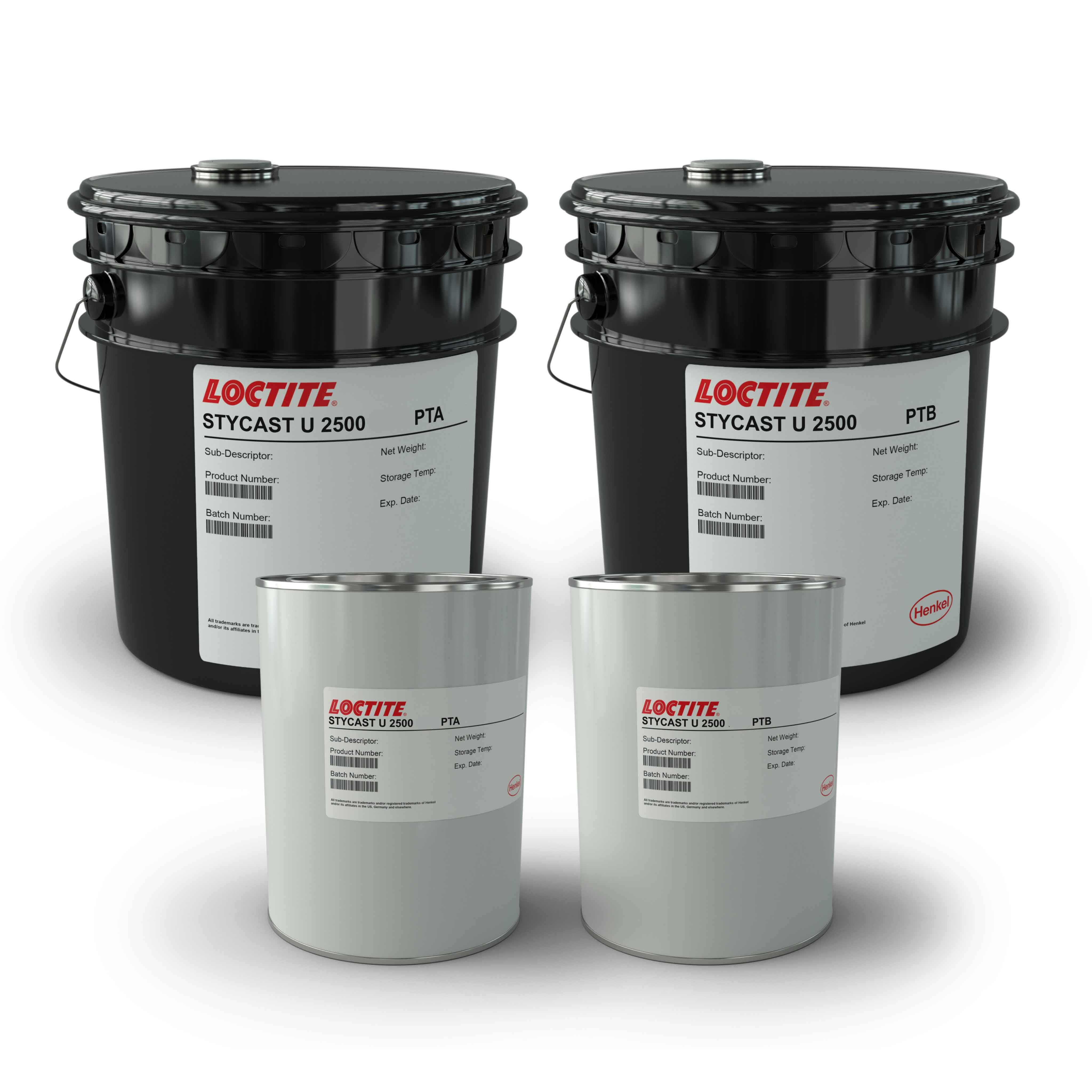LOCTITE STYCAST U2500
Harmonization Code : 3907.30.00.90 | Polyacetals, other polyethers and epoxide resins, in primary forms; polycarbonates, alkyd resins, polyallyl esters and other polyesters, in primary forms : Epoxide resins : Other
Main features
- Two components
- Potting component
- Room temperature cure
Product Description
LOCTITE STYCAST U 2500 is a polyurethane encapsulant designed for transformer, PCB's and other insulation applications. It allows for complete impregnation when used either on small slightly wound coils or large castings.
LOCTITE STYCAST U 2500 exhibits excellent wettability, flexibility and can cure in room temperature. Its operating temperature is between -40°C to 125°C.
Cure Schedule
- 24 hours @ 25°C or
- 4 hours @ 60°C
Complete cure at room temperature will be obtained after 2 to 3days.
Technical Specifications
| Physical Properties | |||||
| Viscosity Viscosity Viscosity is a measurement of a fluid’s resistance to flow. Viscosity is commonly measured in centiPoise (cP). One cP is defined as the viscosity of water and all other viscosities are derived from this base. MPa is another common unit with a 1:1 conversion to cP. A product like honey would have a much higher viscosity -around 10,000 cPs- compared to water. As a result, honey would flow much slower out of a tipped glass than water would. The viscosity of a material can be decreased with an increase in temperature in order to better suit an application | 12,500 mPa.s | ||||
| Chemical Properties | |||||
| Moisture absorption | 0.75 % | ||||
| Mechanical Properties | |||||
| Elongation Elongation Elongation is the process of lengthening something. It is a percentage that measures the initial, unstressed, length compared to the length of the material right before it breaks. It is commonly referred to as Ultimate Elongation or Tensile Elongation at break. | 82 % | ||||
| Thermal Properties | |||||
| |||||
| Glass Transition Temperature (Tg) Glass Transition Temperature (Tg) The glass transition temperature for organic adhesives is a temperature region where the polymers change from glassy and brittle to soft and rubbery. Increasing the temperature further continues the softening process as the viscosity drops too. Temperatures between the glass transition temperature and below the decomposition point of the adhesive are the best region for bonding. The glass-transition temperature Tg of a material characterizes the range of temperatures over which this glass transition occurs. | -53 °C | ||||
| Thermal Conductivity Thermal Conductivity Thermal conductivity describes the ability of a material to conduct heat. It is required by power packages in order to dissipate heat and maintain stable electrical performance. Thermal conductivity units are [W/(m K)] in the SI system and [Btu/(hr ft °F)] in the Imperial system. | 0.5 W/m.K | ||||
Additional Information
Cure Schedule
With LOCTITE CAT 9
- 16 to 24 hours @ 25°C
- 4 to 6 hours @ 45°C
- 1 to 2 hours @ 65°C
With LOCTITE CAT 11
- 8 to 16 hours @ 80°C
- 2 to 4 hours @ 100°C
- 30 to 60 minutes @ 120°C
With LOCTITE CAT 23LV
- 16 to 24 hours @ 25°C
- 4 to 6 hours @ 45°C
- 2 to 4 hours @ 65°C
With LOCTITE CAT 24LV
- 8 to 16 hours @ 25°C
- 4 to 6 hours @ 45°C
- 2 hours @ 65°C
With LOCTITE CAT 27-1
- 4 hours @ 120°C




